In this post I will look at one of the most important criteria you should consider when shopping for an LED grow light, the color spectrum. If you don’t get the right color of light, plants will just not grow well, no matter how much you spend.
If you are looking to get a new grow light, you should really consider LED lights since they are much more energy efficient. That is good for your pocket book as well as the environment. The problem is that selecting the right type of light is no trivial matter. The market is full of products in a wide price range and many manufacturers are making claims that are designed to confuse you.
If you just want a quick answer, head on down to the last section called, The Best Color Spectrum for LED Grow Lights. If you want to understand what you are doing so you can make an intelligent choice, read the whole post. I promise I won’t get too technical on you.
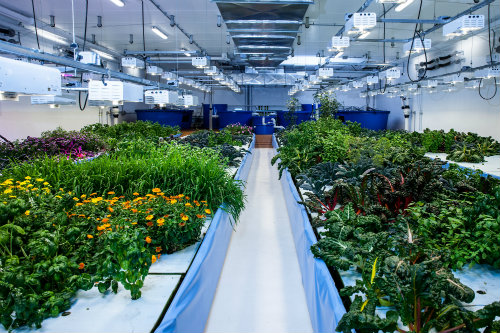
What is a Color Spectrum?
Plants are genetically programmed to grow using sun light, which we consider to be white light, or yellowish-white light. This light looks white because it contains all of the colors of a rainbow, and when these colors are all mixed together they look white.
A color spectrum is a graphical display of each of the colors in the light.
Color spectrum of sunlight, image from Yuji LED
Color spectrum of sunlight, image from Yuji LED
Scientists use wavelength numbers to refer to the colors instead of color names, which is a much more accurate way to measure the color. So a red might have a wavelength of 630 or 660. Both of these look red to us, but they are actually different colors.
Grow lights that use florescent bulbs, refer to the color of the bulb as cool white (has more blue), or warm white (has more red). That was useful for florescent lights, but such designations do not work well for LED lights. When it comes to LED it is more accurate to talk in terms of wavelengths and to display the actual color spectrum.
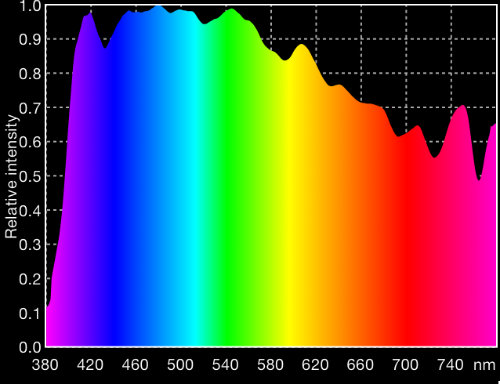
Color Spectrum of the Sun
The light from the sun contains all colors as you can see from the image above. It has more blue light (higher relative intensity) than red.
Which Colors do Plants Use?
Plants use light mostly for photosynthesis and this is done with specific chemicals in the leaves. Examples of the more important chemicals include Chlorophyll A and B. In the absorbance spectrum (measures how much light is absorbed) you can clearly see the peaks in the blue and red regions which means that these colors are used for photosynthesis.
Almost no light is absorbed in the green range.
This has led to the incorrect conclusion that plants only need blue and red light.
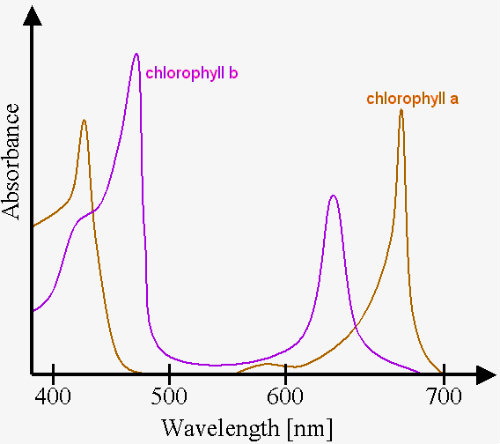
The Myth of Blue and Red
The idea that plants grow well with only blue and red light is in fact a myth. The above color spectrum is for purified chlorophyll in a test tube and it does not show you what happens in a plant leaf. Photosynthesis is more complex and involves other chemicals like carotene and xanthophyll. A color spectrum of the light absorbed by the whole leaf shows that plants actually use a wider range of wavelengths, including green.
It is true that blue and red are important and represent most of the light used by plants, but other colors, including green and yellow are also used for photosynthesis.
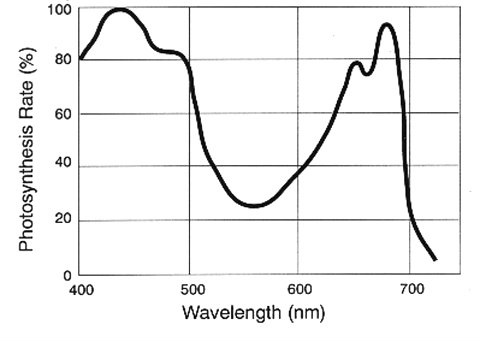
Different Colors Do Different Things
NASA has done extensive work on the light used by plants and they have determined the following.
Red Light (630 -660 nm) is essential for the growth of stems, as well as the expansion of leaves. This wavelength also regulates flowering, dormancy periods, and seed germination.
Blue Light (400 -520 nm) needs to be carefully mixed with light in other spectra since overexposure to light in this wavelength may stunt the growth of certain plant species. Light in the blue range also affects the chlorophyll content present in the plant as well as leaf thickness.
Green Light (500 – 600 nm) penetrates through thick top canopies to support the leaves in the lower canopy.
Far Red Light (720 – 740 nm) also passes through dense upper canopies to support the growth of leaves located lower on the plants. In addition, exposure to IR light reduces the time a plant needs to flower. Another benefit of far red light is that plants exposed to this wavelength tend to produce larger leaves than those not exposed to light in this spectrum.
Color Spectrum of LED Bulbs
It is important to distinguish between LED bulbs and LED lights. An LED light is the complete fixture and it can contain one or more LED bulbs; usually more than one. The LED bulb is the small individual component that makes light.
LED bulbs exist for specific wavelengths. This image shows the spectra of three bulbs; blue, yellow and red. Note that each bulb produces a fairly narrow spectra. The blue bulb for example is about 60 nm wide, and contains only blue light.
Since many people believe that plants need only blue and red light, many of the lower cost LED lights offer only blue and red LED bulbs. This seems like a perfect solution, especially since blue and red LED bulbs are more efficient and less expensive than other colors.
A lot of the LED grow light pictures on the internet show a ‘burple’ light – the industry name for the color made by using a combination of blue and red LED bulbs.
LED bulbs are now available in more than a dozen different colors.
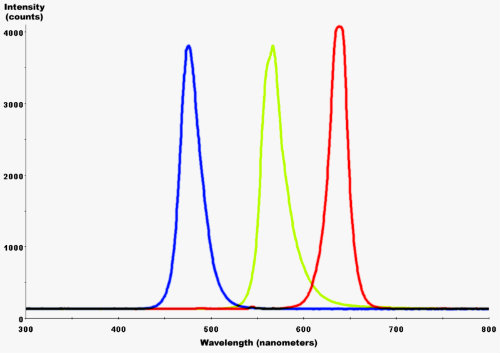
Intensity is Also Important
So far we have focused on the color spectrum which is very important, but light intensity is also important. For years the go-to grow light for greenhouses has been a high intensity sodium lamp. I have used it for years and it works great for both seedlings which need lower levels of light and flowering orchids which need high light. It is a very yellow light with only a small amount of blue, but at 400 watts it has a very high intensity. The high intensity means that even though blue is a minor component of the light there is still enough to grow plants.
The white LEDs mentioned above seem like a perfect solution, but they have a lower intensity than non-coated bulbs. For this reason non-coated bulbs are still a good option.
Don’t Count on Lumens
Intensity is important, but how do you measure it?
A common way to do this is to measure lumens, which is a measure of how bright a light is. The problem with lumens is that it measures how bright the light appears to the human eye and our eyes see green and yellow light much better than blue and red.
A light that produces mostly blue and red will not look bright to us, and therefore it will have a low lumen number. A yellow-green light, giving off the same number of photons, looks bright to us so it has a high lumen value. But this high lumen light does not have the optimum color spectrum to grow plants. Lumens are great for selecting light for the home, but mostly useless for selecting LED grow lights.
You might wonder how lumens relate to LUX and foot candles. Lux is lumen/m2 and foot candle is lumen/ft2.
The Best Color Spectrum for LED Grow Lights
What is the best color spectrum for LED lights? It should be close to the spectra used by plants. Lots of blue and red, and some green and yellow. Add some near IR and maybe even near UV and it is even better.
Don’t worry about matching the sun or white light.
I think it is important to see the output spectra of a light before you buy, but most manufacturers don’t show these. The new proposed labels for LED grow lights, will show PPFD (called PFD) for various ranges of wavelengths, including the PAR range.
Comparing PPFD values is the next best thing. A higher PPFD will provide more light for plant growth.
References:
Photo Source, Aquaponics Image; https://www.greenrelief.ca/
Photo Source, Spectra of LED Bulbs; Deglr6328
Photo Source, LED PAR spectra, https://fluence.science/science/photosynthesis-guide/
If you like this post, please share .......
Contact: Starry
Phone: +86-1-392-655-9500
E-mail: info@koosion.com
Add: 1807# Baoan Ave, Baoan District, Shenzhen City, China